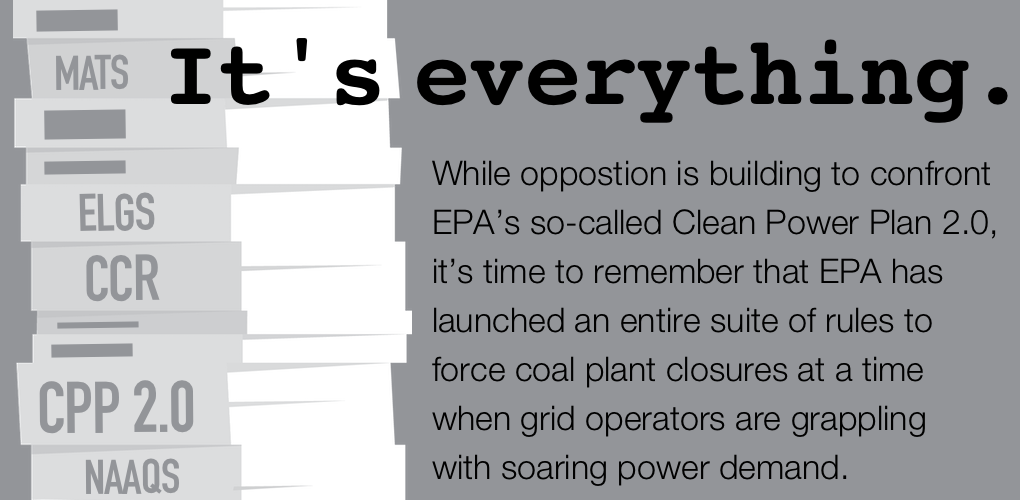
It’s the Entire Suite of Rules
Lawsuits are piling up in opposition to the U.S. Environmental Protection Agency’s (EPA) so-called Clean Power Plan 2.0. Senator Capito of West Viriginia and Congressman Balderson of Ohio have led the charge in pursuing a Congressional Review Act (CRA) joint resolution of disapproval of the rule. This mobilization of opposition is deeply important to confronting EPA’s agenda but it’s critical to not lose sight of the danger posed by the entire suite of rules EPA has launched at the coal fleet.
The CPP 2.0 is in fact batting clean-up for a blitz of other rules that were always intended to do just as much – if not more – heavy lifting in forcing coal plant closures.
The Steam Electric Power Generating Effluent Guidelines and Standards (ELGS), Mercury Air Toxics Standards (MATS), Ozone Transport rule, Coal Combustion Residuals (CCR) legacy surface impoundment rule, particulate matter National Ambient Air Quality Standards (NAAQS) and Regional Haze state implementation plan disapprovals are all crashing down on the fleet. The cumulative impact of these rules is forcing plants offline even faster than the 2032 deadline in the CPP 2.0.
And make no mistake, this was always the EPA’s design. In fact, in 2022, EPA administrator Michael Regan boasted that he didn’t even need a new carbon rule to slash emissions. He’d use a suite of other rules to force plant closures and has now made good on that boast.
“The industry gets to take a look at this suite of rules all at once… and if you get an expedited retirement, that’s the best tool for reducing greenhouse gas emissions,” said Regan.
He added, “I don’t believe we have to overly rely on any one regulation.”
The grid operators – now grappling with soaring power demand – understand the threat posed by the entire suite of rules. PJM Interconnection, the grid operator of the nation’s largest power market serving 65 million Americans, warned on May 8th that it is EPA’s rules – not just a single rule – that are incompatible with surging power demand.
What is true for PJM is true across the country. Utilities, co-ops and grid operators will be short of power as demand soars, plant closures accelerate and the challenges to building new generating capacity and energy infrastructure continue to mount.
PJM’s Vice President of Planning, Paul McGlynn, recently observed, “according to Lawrence Berkeley National Laboratories, more than 300,000 MW of projects have been approved nationally but have not proceeded to construction – nearly 25% of current generating capacity in the country. Right now, PJM has cleared nearly 40,000 MW of generation projects through our interconnection process that are not moving to construction. Nothing from PJM is holding these projects back, yet they sit idle in PJM and elsewhere due to continued challenges with supply chain, financing and local siting issues.”
As demand soars and states are left with inadequate power supplies, grid emergencies will become a far too regular occurrence, and electricity demand destruction from eroding industrial activity will follow.
Shortages of power will set off a domino effect with no state left untouched, placing electricity supply handcuffs on the nation’s economy. New manufacturing facilities – producing everything from semiconductors, batteries and cars – will struggle to find power and when newly proposed facilities can’t, they simply won’t be built leaving investment, jobs and untold economic potential just sitting on the table. This is the bleak reality coming for the nation if we don’t check the EPA’s regulatory agenda and its entire suite of rules designed to dismantle the nation’s coal fleet when it’s needed more than ever.
- On June 12, 2024
